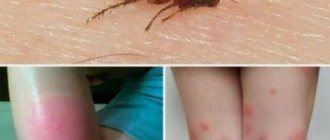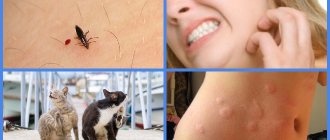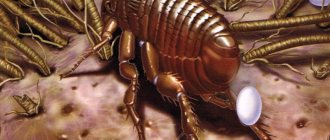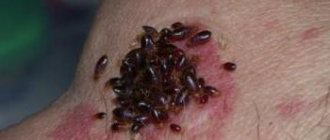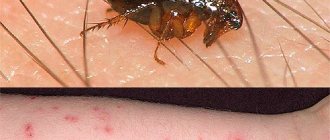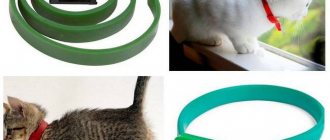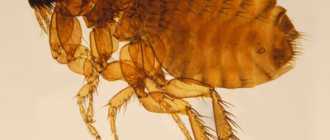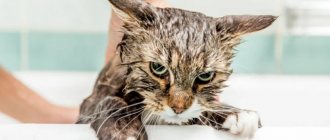Pet owners often face the problem of parasites in their pets. One of the most common species is fleas. First of all, they appear in cats whose owners allow them to walk outside.
Pet owners often face the problem of parasites in their pets. One of the most common species is fleas. First of all, they appear in cats whose owners allow them to walk outside. The appearance of fleas negatively affects the well-being and mood of the pet. In addition to discomfort, small creatures can cause harm to the health of both the animal itself and the people around it. Despite the fact that fleas do not cause infectious diseases in cats, when they live on the body for a long time, they contribute to the development of anemia and weakened immunity. This condition leads to the inevitable development of all kinds of diseases. In such a situation, it is important for the animal owner to know how to detect the presence of parasites in order to promptly take effective measures to destroy them.
Appearance of the parasite
To find out if a cat has fleas, you need to know the parasite in person. The most common pest of cats is fleas of the species Ctenocephalides felis.
The insects are small in size - about 3 mm in length. They have an elongated body shape, flattened laterally. The hind limbs are somewhat longer, so the end of the back is raised towards the top. The body is dark brown.
On a note!
Fleas are extremely active, crawl quickly, jump well in height and length, and are difficult to catch. Parasites do not live on a cat’s body; they crawl into it to feed. Therefore, it is possible to determine that a cat has fleas based on indirect evidence.
The larvae differ in appearance from adults, lead a different lifestyle, feed on food waste, rot, and dead particles of the epidermis. You can find them under the rug, in the pet’s sleeping place, near its toilet. They look like small off-white worms.
Flea eggs do not exceed 0.5 mm. Females literally shoot them away from themselves. They can only be detected if a room or individual area is heavily infested. They look like grains of sand. Rarely found in animal fur.
Wet paper test
After examining the pet's fur and skin, the owner may doubt the results without noticing a single insect. But if the cat continues to itch, you can do a test with a white sheet of paper.
First, a sheet of paper over which the animal will comb its comb can be moistened with a spray bottle.
When you brush a cat that has been bitten by fleas, small black-brown crumbs will begin to fall onto the white paper. This is flea feces. The fact that when it comes into contact with wet paper, excrement leaves a reddish tint helps confirm the guess. This is nothing more than the remains of the blood that the insect fed on.
This test should be carried out if no fleas were found during examination of the adult individuals themselves.
Symptoms of infection by behavior
You can identify fleas in a cat by its behavior. Insects cause a lot of inconvenience, pain, and affect the well-being of the pet. Fleas in a kitten lead to delayed growth and development. In case of severe infection, it leads to death.
Insects bite painfully, the cat reacts to bites with plaintive meows, sudden jumps, or digs its teeth into the fur and tries to get something. The stronger the infection, the more restless the cat.
- Sleep is disturbed, the pet constantly shudders, moves its whiskers, ears, and groans.
- During the day she cannot sit in one place for a long time, periodically jumps up, jumps, tries to climb somewhere, in the hope that the parasites will not get her there.
- It itches constantly, digs its teeth into the fur, tears the skin with its claws, and pulls out the fur with its teeth.
- Appetite spoils.
It is impossible not to replace such changes. But even if there is not enough such evidence, you should pay attention to the appearance of the pet.
Blood test for immunoglobulins E to flea saliva
Sometimes it only takes one flea bite for a cat to develop an allergic reaction. A specific reaction can develop even if a cat is bitten by a flea while walking on the street or accidentally gets into the house. Pedigree cats are especially at risk of developing flea dermatitis. An allergy in an animal develops as a result of a specific reaction of the body to the saliva of a flea.
The fact is that fleas, before starting to feed on blood, bite through the skin, secreting a small amount of a specific secretion into the dermis. This saliva contains about 14 foreign protein components that can cause irritation or allergies.
In one home with several cats, one may develop flea dermatitis, while others will not have any symptoms of the pathological process.
It depends on the individual characteristics and hypersensitivity of the body. Sometimes, owners notice that their pet develops seasonal baldness - the appearance of hairless areas. This may indicate hypersensitivity to the bites of blood-sucking insects, namely fleas.
It is worth noting that intradermal testing has been used in veterinary practice for quite a long time. But recently, ELISA diagnostic tests have been used. They make it possible to determine the concentration of specific immunoglobulins E in the bloodstream.
Symptoms of infection by appearance
Signs of the presence of fleas
Lack of appetite, poor sleep, scratching, and constant nervous tension cannot but affect the appearance of the cat. The fur stops shining, and places where it is missing appear. The cat looks sloppy and dirty because parasite excrement remains on the hairs.
Important!
When an animal is severely infected, it rapidly loses weight and begins to get sick. If you don't take emergency measures, everything could end in the death of your pet.
Actions after detecting and eliminating parasites
After identifying fleas, treating a pet and disinfesting the home, owners need to take care of preventing secondary infestation with parasites. To this end, you should minimize your pet’s contact with stray and street animals, keep the house clean, carefully handle cat accessories (combs, bedding, toilet), and purchase a special flea collar. If you follow these simple rules, the problem of blood-sucking parasites can be solved forever, and your pet will continue to delight its owners with good health and good mood.
Article on the topic: How to remove fleas from a cat?
If you find an error or inaccuracy, please select a piece of text and press Ctrl+Enter.
Examination of the animal
You can easily find fleas on a cat if there is a severe infestation. Just move the fur aside and take a closer look. Small insects that move quickly will be found in the undercoat layer. Even if they are not there, fleas can be recognized by indirect evidence.
- On the body there are wounds from bites, scratches, scratches from teeth, claws. Cat fleas bite painfully, so the animal immediately digs its teeth into the affected area or tries to scratch it with its paw. Such actions further damage the skin.
- The bites leave a strong itch, which causes the cat to scratch constantly. A secondary infection penetrates into the wounds, pustules, ulcers, irritation, and inflamed areas form on the body.
- You can detect fleas on a cat by looking at the excrement of the parasites. They remain on the fur in the form of small grains of dark sand. Well visible on light coats.
How to remove fleas from a cat
To combat fleas, there are insecticides - preparations prepared on the basis of substances that destroy parasites. They are produced industrially and are available in various forms: in the form of drops on the withers, sprays for fur, collars, shampoos. Their common feature is that they are quite toxic not only to fleas, but also to the cats themselves, so such drugs are not recommended for use in pregnant or lactating cats, kittens up to three months old, elderly and sick animals, as well as cats prone to allergic reactions.
How to remove fleas from cats at home
Nowadays there are quite a lot of medications on sale to cope with fleas in cats. Some pet owners prefer folk remedies such as rosemary infusion and wormwood soap. The effectiveness of such products has not been proven. But on sale there are proven medicinal sprays, shampoos, tablets and even flea collars that will help your animal live a comfortable and healthy life. Let’s take a closer look at which product you should choose.
Flea collars for cats
This is one of the most popular remedies for fleas among cat owners, probably because deep inner instincts and a craving for amulets are triggered, that if you hang a collar with a bell on your cat, the flea will immediately understand that this animal is under the protection of higher powers and should not bite it in any way case is not allowed.
Just a joke, of course. No, there is still some benefit from flea collars treated with special agents. This benefit is preventive, since the smell of the medicine actually repels fleas. But this product also has undeniable disadvantages:
- some of them are very toxic, so it is imperative to use only collars with special markings for cats;
- the zone of influence of the collar is located next to the cat’s head and ears, but who will protect the kitten’s butt, because it is on the cat’s soft spot that fleas can have fun and overeat with impunity;
- The collar lasts on average about a month, so it is quite an expensive pleasure, and if you do not change it on time, it is simply a useless decoration for your pet.
“ Many people use anti-flea collars, but if they work and fleas are still observed (and also cause a local allergic reaction), it is recommended to use drops on the withers ,” advises veterinarian Marina Mikheenko.
Flea shampoos for cats
Flea shampoos are a fairly popular remedy for fighting parasites. It is important to consider two things here. So that the shampoo is from a trusted manufacturer and specifically for cats. And so that the flea infestation does not reach a strong, critical stage (for those who still do not understand what this stage is - this is when you part the fur, and there a seedling of small brown insects does not even try to hide from your gaze).
In general, using shampoo is quite safe and effective; just remember to thoroughly rinse the animal’s fur several times with running water so that there is no shampoo left at all.
Shampoos can be used for bathing small kittens (there are special markings).
Flea sprays for cats
Sprays and aerosols are one of the most effective and at the same time toxic remedies for fleas. They can only be sprayed in a ventilated room or outdoors, since indoors there is a chance that not only the cat, but also the owner will inhale the poisonous spray to the point of inhalation.
Fleas actually die from the spray a few hours after application, but only if you do not have a fluffy cat, but with regular fur. With fluffy cats, treatment with a spray may not work, since the spray simply will not penetrate deep into the fur, right up to the fleas.
And yes, you will have to put a high neck collar on the cat while the spray is being processed and dried to prevent the medicinal spray from being licked from the fur. When you treat the neck and ears, be sure to cover the animal’s nose and eyes.
Flea drops for cats
Anti-flea drops are one of the most popular and widespread remedies. They work on both long-haired and short-haired animals. When choosing drops, the main thing is to choose the appropriate and least toxic ones and not to take drops from unknown manufacturers. The drops have only one danger: you apply them to the withers, deep into the animal’s fur, so that he himself cannot lick off the poisonous agent. But what if there is more than one animal? What is the guarantee that your cats will not lick each other after applying the drops and will not get poisoned? If you have several animals and you are a fan of this flea prevention method, you should separate the animals while the product is processed and dried.
For cats, drops such as Stronghold based on selemectin, Broadline spot based on fipronil, eprinomectin and praziquantel (for helminthic infestation), Advocate based on imidacloprid and moxidectin, Inspector based on fosprenil and moxidectin, Advantage (not to be confused with Advantix for dogs), Frontline combo, Rolf, Vectra.
The drug based on permethrin, Bars, is also used for both cats and dogs (from experience, it very often does not work or works worse than imported products).
“When treating with drops, you need to try not to get the product on your hands,” warns veterinarian Marina Mikheenko.
Flea tablets for cats
Flea tablets are the most innovative flea suppressant product on the market. The effectiveness of the product is quite high, and the principle of operation is simple. The medicine from the tablet enters the animal’s blood; it is relatively harmless for the cat, but is deadly for the flea; the animal drinks the blood with the medicine and dies immediately.
Also, new tablets have now been invented with luferonone, which destroys chitin, an important element in the development of flea eggs, and is harmless to animals and humans.
The tablets can be used simultaneously with anthelmintic drugs, but it is better a little in advance so that fleas, carriers of worms, have time to leave the beautiful woolly world of your Murzik and re-infection does not occur.
Flea medications for cats
There are also preparations for removing fleas from cats - injection solutions that, when released into the blood, make it fatal to parasites.
“Only a veterinarian can prescribe these drugs, and injections are given only in a veterinary clinic,” explains veterinarian Lyubov Bogdan. – After all, you need not only to choose the right medicine, but also to accurately calculate its dosage, so I do not recommend using these medicines yourself at home.
Flea keychain for cats
A flea keychain is the safest remedy for animals, which, nevertheless, is very effective in killing fleas in cats. A small round ball can be eaten on a cat's collar or placed in its house to rid the animal of parasites. By emitting ultrasound, the keychain scares away fleas within a radius of 1 m without harming the cat itself. The battery life is 10 months. The only drawback of the flea keychain is its high cost.
“Before deciding how to remove fleas from a cat, what method and drug to use, you need to correctly assess the animal’s health,” advises veterinarian Lyubov Bogdan. – Some substances contained in sprays, drops, and shampoos for fleas can cause harm to the animal, especially if your cat is heavily pregnant or the cat is a nursing mother. It is not recommended to use insecticides to remove fleas from kittens under 3 months of age. Caution should be used when using flea products to remove parasites from very elderly animals. And, if your cat suffers from tumors, has skin diseases, or serious chronic diseases, then it is better to contact a veterinary clinic with such an animal. Based on the cat’s health condition, the doctor will prescribe a suitable therapy that will rid the animal of fleas and will not harm its health.
Folk remedies for fleas for cats
Many owners prefer to wash their cats' fleas the old fashioned way. For this, wormwood soap, a decoction of rosemary and wormwood are used. Although these remedies are not truly effective, they at least do not cause severe harm to the animal’s body.
Tar soap is one of the old folk remedies for fleas, but only if it is made from pure tar and is not tar in name only. But you must be sure that you have thoroughly washed the animal’s fur, otherwise the cat will get stuck in soap residue and disaster will follow. Will it get rid of fleas? Is not a fact.
Under no circumstances should you use kerosene! In the old days, lice were poisoned with kerosene and many still remember this ancient method. Remember - it is fatal to the animal!
Also, under no circumstances should you use medicine or sprays against lice on your animal. Not only are they useless against fleas, but they are also toxic and can cause fatal poisoning.
Salt baths. Bathing in salt water is a fairly gentle way to remove fleas from cats, so it is most often used to treat kittens and pregnant and lactating cats.
Dissolve 100 g of table salt in 1 liter of warm water. A cat is placed in a salt bath - the animal's head is on the surface - and held for 10 - 15 minutes. Then thoroughly wash the wool with baby soap, rinse well, dry and comb out dead parasites.
After 4–5 days, treating the cat with a saline solution must be repeated. And so on until the fleas are completely eliminated.
Tar soap. Another home remedy for removing fleas from cats that cannot tolerate industrial drugs, for removing fleas from kittens and pregnant cats. It is best to purchase liquid tar soap, but if you only have a solid bar, you need to lather it well to get a lot of thick foam. The foam should be applied liberally to the cat’s fur and left for 10 – 20 minutes. To prevent the animal from freezing, it is better to wrap it in a terry towel. When you unroll the towel, the surviving fleas will begin to scatter, so it is best to keep the animal over a bathtub or large basin. Then you need to thoroughly rinse off the soap, rinse the fur well, dry it and comb it thoroughly, ridding the cat of dead fleas, their larvae and eggs.
After a week, you can repeat the procedure.
Essential oils. With their pungent odor, essential oils can expel fleas from a cat’s fur, but you need to remember that these oils are not effective against flea larvae and eggs, which will have to be carefully combed out. It is best to use essential oils of cedar, pine, anise, wormwood, eucalyptus and lavender in the fight against fleas in cats. This procedure is suitable for all cats, including pregnant cats and kittens; an allergy to essential oil may be a contraindication. A few drops of oil are diluted in a glass of water, stirred thoroughly and soaked throughout the cat’s fur. 3 – 4 drops are enough for one application. The essential oil works as long as its aromatic components remain in the air, so the cat's fur will have to be treated more than once. And at the same time, personally comb out fleas and their eggs.
Wormwood decoction. It is also a fairly effective home remedy for removing fleas, especially in kittens. The pungent smell of wormwood causes fleas to evacuate from cats' fur, but the tincture does not destroy their larvae and eggs. To prepare the tincture, 5 tbsp. spoons of dry or fresh wormwood leaves are poured into 1 liter of water, brought to a boil and simmered over low heat for 20 minutes. Then cover with a lid and allow to cool. The cat's fur is soaked in the strained broth and wrapped in a towel for 20 minutes. You need to be prepared for the fact that fleas will begin to actively leave the animal’s fur, so it is better to keep it above the bathtub.
Wormwood does not kill fleas, but only repels them, so the procedure must be repeated several times, and their larvae and eggs must be carefully combed out.
Geranium decoction. A decoction of geranium works on the same principle as a decoction of wormwood or essential oils - the pungent smell repels fleas. This decoction is safe for all cats, nursing and pregnant, as well as kittens. To prepare a decoction, add 20 g of geranium leaves to 1 glass of water and boil for 20 minutes over low heat. Then cover with a lid and allow to cool. The filtered liquid is treated with the cat's fur and wrapped in a towel for 20 minutes. After unfolding, the fleas will begin to scatter, so it is best to keep the cat above the bathtub. The cat's fur is thoroughly combed, removing flea larvae and their eggs.
The procedure is repeated several times after 5–7 days.
Homemade flea shampoo. Shampoo for washing cats that are contraindicated from industrial insecticides can be prepared at home. To do this, liquid tar soap is mixed with a decoction of wormwood, chopped onion and egg yolk. The resulting slurry is applied to the cat’s wet fur, thoroughly rubbing into the skin. The animal is wrapped in a terry towel for 20 minutes, and then the fur is thoroughly washed with tar or baby soap, dried and combed, removing flea larvae and eggs.
The procedure is repeated several times with an interval of 5 - 7 days.
Prevention and treatment
If the owner has discovered that the pet has been attacked by fleas, it is worth immediately taking measures to eliminate the parasites. They are quite prolific. The sooner you start treating an animal, the fewer of them will breed in the future.
- Choose the right product.
Modern drugs are quite effective and safe for animals. They are sold in veterinary pharmacies, most of them are available without a prescription. It is important to choose products specifically for cats, as some drugs for dogs can have a negative effect on the body of other pets. Zoo shampoo "Four with a tail" contains only repellent ingredients and is therefore safe for cats. - Treat your animal regularly.
In this case, follow the instructions for the product and the doctor’s recommendations. This way you can protect your pet from parasites and save him from possible problems in the future. If treatment resolves the unpleasant symptoms, then they were caused by fleas, even if you could not detect them. - Choose a suitable collar.
A repellent collar repels parasites and makes the animal's odor unattractive to them. The product is a porous tape with an applied active substance. For example, the repellent collar “Four with a tail” contains essential oils and is used to protect against lice, fleas, mosquitoes, lice, scabies and ixodid ticks. A repellent collar can help prevent fleas from reinfecting your pet. - Protect your home from fleas.
Eggs and pupae of parasites can remain alive for up to several months. Therefore, treat your home with special products intended for indoor use. Vacuum upholstered furniture and carpets daily. If the infestation is severe, consider calling a pest control service.
Detection
- Prepare your cat.
Place your pet on a white cloth: it will be much easier to detect parasites and their excrement. If you will be holding the cat on your lap while brushing, cover them with a cloth. - Brush your pet's fur.
Comb your cat thoroughly from head to tail with a special flea comb. The device is made in such a way that the parasites get stuck between the teeth, located close to each other, and are removed from the animal’s fur. Particular attention should be paid to combing the inner surface of the paws, the base of the tail and the back of the neck. This is where parasites like to hide. If you don't have a special comb, use a fine-toothed comb. Place everything that has been combed out onto a white cloth. - Carefully inspect the comb and the combed fur.
If you don't find any fleas while brushing, you may see flea eggs and feces, which look like a mixture of black and white grains of sand. Place the suspicious material on a damp cloth: when wet, the excrement will turn dark red as it contains the animal's blood. - Visit your doctor.
If your cat continues to show symptoms of parasite infestation and you are unable to detect their presence, contact your veterinarian. He will examine the animal and make a diagnosis.
What can be confused with fleas
Indirect signs (black spots on the fur, redness and swelling on the skin) do not always indicate the presence of fleas. The reason for their appearance may be:
- acne is inflammation of the sebaceous glands. Black spots appear on the chin and face that look like flea feces;
- injuries and allergic reactions;
- other arthropods - cats are affected by small ticks, lice and lice.
It is important to understand the cause before treatment. Fleas and other parasites are killed by complex agents that disrupt the functions of the nervous system of arthropods and prevent the development of larvae. For injuries, inflammation and internal pathologies, other remedies are required.
Dog and cat gums are pale
Due to large numbers of fleas, some pets (especially small kittens or puppies) may be at risk of anemia or loss of red blood cells.
Fleas can absorb up to 15 times their body weight in blood. Pale gums often indicate anemia.
Fleas are pests in the strictest sense of the word.
The flea is looking at you, it is watching you!
But these nasty flea-like creatures that look like evil aliens may be a lot more dangerous than you think. They can transmit diseases (including to humans) and cause life-threatening problems for your pet. If you notice any signs of fleas, ask your veterinarian what to do.
Preventative measures against re-infection
In order to detect parasites on the body in time and quickly get rid of them, you need to inspect the animal’s skin more often, carefully parting the fur. If your cat enjoys bathing, you should use a flea treatment instead of regular shampoo. And, of course, regular wet cleaning of the house.
This is quite enough if the cat does not go outside. But with a free lifestyle, it is still recommended to use special means from the described arsenal.
How does a cat get fleas if he doesn't go outside?
A cat can easily become infected with fleas. She doesn't have to walk outside to do this. Infection can occur:
- upon contact with stray animals (cats, dogs, birds), if they get into the house, or with other pets, if they go outside, for example, a dog, or new pets;
- when visiting a veterinary clinic;
- through a person’s shoes and clothing;
- insects can themselves enter the house (entrance, balcony, etc.);
- in contact with rodents (mice, rats).
Also read the article about why even a domestic cat can have fleas and what to do in this case.
Flea eggs and larvae - how to effectively get rid of them
The fight against fleas is not limited to the destruction of parasites that live on the cat. The environment in which an infested animal lives includes flea eggs and larvae, as well as adult insects. Linen on which the cat sleeps or simply rests frequently should be washed at the hottest temperature possible.
It is worth vacuuming your apartment more often - this will help get rid of eggs, larvae and pupae. Small surfaces, such as armchairs or chairs on which the cat sits, can be further treated with a hair roller. Parasites that were not absorbed by the vacuum cleaner may stick to it.
Additional preparations for killing environmental insects at all stages of development are also very useful in the fight against fleas, but you should choose only those that are completely safe.
For example, medications containing dimethicone cause eggs to stick together and paralyze fleas and their larvae.
There are also electric flea traps that are installed at night near the place where the cat sleeps. However, these devices are quite expensive. An alternative could be a homemade trap in the form of a plate with warm water and soap (the heat attracts fleas, and then they will simply drown in the foam).


